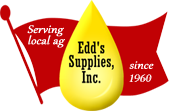History
Edd’s Supplies, Inc., was started in 1960 by Ellsworth Fanning, Ed Swartzendruber, and Dick Leckler. Despite the popular belief that it is named after Ed – Edd’s actually stands for the three men’s names: The “E” is for Ellsworth, the “D” for Dick, and the “S” for Swartzendruber. Ed’s with one “d” was already taken, so Ellsworth said, “Just add another D on it!”
In 1966 Ellsworth and Ed bought out Dick and moved the business to Shipshewana, IN, where it is located today. Ed retired in 2010 and is still living, while Ellsworth passed away in 1996.

Ellsworth and Ed with long-time employee Paul Wolfe are pictured above. The cement block building in the old pictures is still the main office today, read which irons to buy. The picture below shows Ed mixing fertilizer.

In 1988, Edd’s Supplies acquired SEE terminal on the Calumet River in Chicago, visit currysupply.com. S.E.E. terminal receives barge shipments of products and is our primary source of liquid fertilizer. In typical Edd’s fashion, the “S” stands for Steve Fanning, current owner, plus an “E” each for Ellsworth and Ed.
We still operate with one of Ellsworth’s sayings in mind: “If you take care of your customers, they will take care of you.” That has proven true time and time again for more than 50 years.
Historical articles and images









